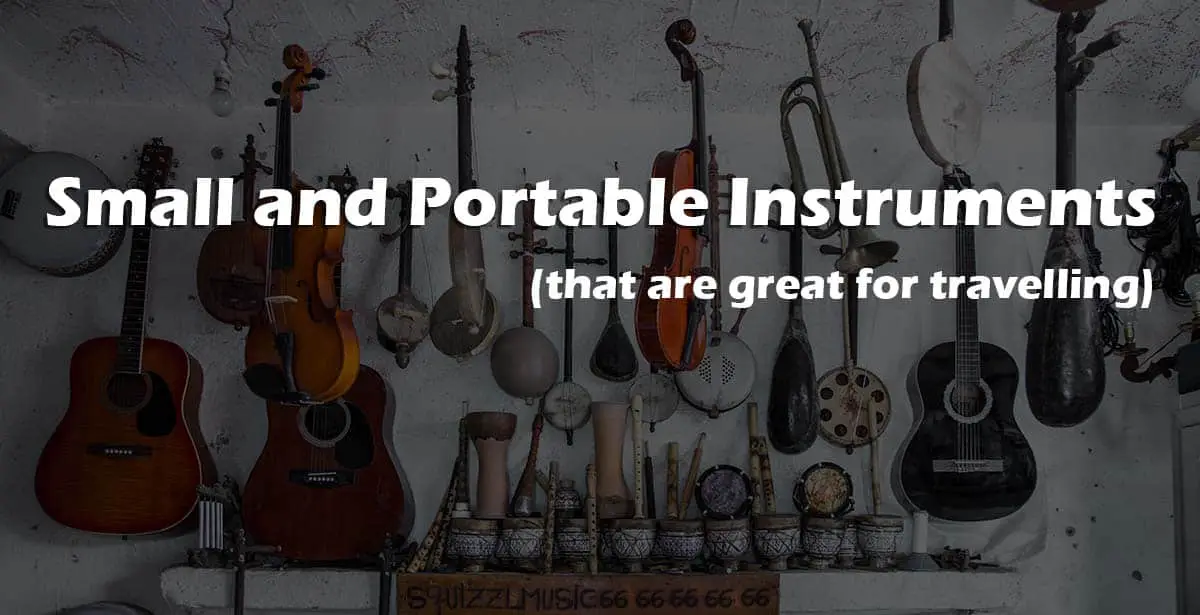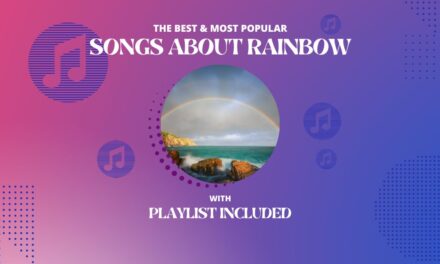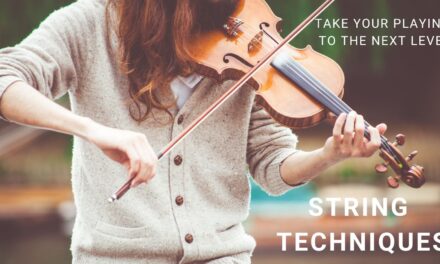Trust me, I get it.
I have spent countless hours roaming city streets and airport walkways with a banjo or guitar as I shift the instrument from one hand to the other to save strength in my arm only to be crushing my back anyways.
It is difficult and a bit absurd to bring around a large instrument if you plan on traveling and moving around to different parts of the world (or even just your home country).
This article aims to explore the best options for small and portable musical instruments that could be a great option if you have wanderlust and want to hit the road without breaking your back.
Top 20 Small Instruments that are Portable
There are obviously many different factors when choosing a portable instrument and we aim to cover most of these considerations in detail.
For example, you might want an instrument that is professional-grade and requires a good deal of previous musical experience at a higher price. Perhaps, you might be a beginner looking for the perfect instrument to sing along to around a fire on the beach. Either way, here are some of the top choices depending on what you are going for.
Ukulele
When it comes to small and portable instruments, the ukulele will likely be the first musical instrument that most people consider. It is a popular instrument, has a low price tag, and has one of the easiest learning curves available. Not only that, but it is the perfect accompaniment for those wanting an easier instrument to play while singing.
The ukulele is going to be a great fit for beginner musicians and for newcomers looking for a rhythm instrument to play while singing songs without a band. It has only 4 strings, a small neck, and is usually played with nylon strings and is a common instrument among Hawaiian and folk music.
Overall, the ukulele is a great choice for solo players and beginners looking to sing with an affordable rhythm instrument.
Mandolin
The mandolin is going to be a great choice for those looking for a more advanced (and pricey) instrument that can be strummed while singing and has limitless musical progression.
The mandolin features a total of eight strings but is grouped in sets of two – so it is basically played like a four-stringed instrument. As a member of the lute family, it is commonly seen in American bluegrass, folk, and country music.
A mandolin is likely going to be much better quality and much more expensive than a ukulele. But, there is no doubt that there is much more that can be done with a mandolin for musicians looking for advanced progression beyond playing chords and singing songs.
The mandolin would be a better choice for more experienced musicians that are looking for a portable instrument that can provide more advanced musical ideas and lead solos.
Beat Production and Synthesizers
This may seem like an odd choice at first but hear us out. Especially in a time where content creation and custom audio are such a prominent part of influencers and social media, a portable studio could be a great way to create music while traveling.
If you are already traveling with a laptop, then you may only need an audio interface, microphone, and drum sampler or synthesizer to open a world of possibilities with audio creation. These few items would take up much less space and weight than a standard acoustic instrument.
If you are interested in content creation, social media, or creating beats, then this might be the perfect option. Installing a DAW (digital audio workstation) along with a few of the items mentioned could keep you busy for a lifetime with unlimited possibilities.
Think about it. You can come up with endless options with a professional microphone, DAW, and a laptop. Just with vocals alone, you can install and use a large variety of digital plugins for effects that are commonly found in pop music.
If you are a content creator, influencer, or want to create beats and musical ideas in the comfort of your own home (or Airbnb for travelers) then this is a great choice for you.
Guitalele
If you want the portability with the possibilities of a guitar – you can grab yourself a guitalele, which is a miniature version of the guitar the size of a ukulele.
This is the perfect alternative for someone who already plays guitar but wants something in a smaller size for traveling. It can be a great option for beginners as well who want to provide more musical expression than the limits of a ukulele.
Many guitaleles available also come with a prebuilt pickup which allows you to plug into a live sound system.
Overall, the guitalele is fantastic for those who know their way around a guitar and want something more portable and advanced than a similar instrument like the ukulele.
Harmonica
The harmonica is one of the most portable instruments available and if played correctly, can provide incredible melodies to accompanying rhythm instruments. Although, one single harmonica might not do the trick when playing with others. Each harmonica comes in a specific key so if you are playing melodies with other musicians, you might consider having a set of harmonicas in different keys.
Fortunately, you can likely get away with having a set of 3-4 harmonicas in the most popular keys rather than buying a set of 12 in each key (because how many players are playing a song in the key of D#?).
At first glance, it may seem that the harmonica is simple and does not have much in terms of musical progression – but in fact, there is so much that can be done with a set of harmonicas and the techniques involved.
The downfall comes from the lack of an instrument that can be played solo without accompanying musical instruments. As a primarily melodic instrument, it is best played with others. It is commonly found in rock, blues, country, and folk music.
The harmonica is a great choice if you want to play with others with great melodies in styles like blues, rock, and folk.
Violin
The violin is perhaps one of the more difficult instruments to play on our list. With that said, the complexity of the musical instrument gives it such an incredible sound when played both solo and as a melodic instrument with a backing rhythm.
It is such an exquisite instrument often associated with classical music and orchestra but can also be found in folk, country, and bluegrass genres (and will be referred to as a fiddle). A beautiful voice that can be soft and sweet – but also ripping when kicking down with some barn-stomping bluegrass.
The challenge here is the learning curve that comes with the violin. It is not an easy instrument to just pick up and can be loud and obnoxious to others when first learning – making it difficult to learn in a quiet or small setting like an apartment.
Flute
The flute is unique compared to other woodwind instruments with its small size and the fact it does not use a reed to play. Producing sound by vibrating air produced from the mouth, it is one of the earliest known musical instruments in history.
Today, the flute can be found in all sorts of musical genres including classical, rock, bluegrass, gypsy jazz, and folk music.
It is extremely easy to pack and can produce an incredibly beautiful sound that will be sure to impress anyone around. This comes at the price of being a challenging instrument to play. If you are willing to put in the hours, then the flute will have a high payoff for the intermediate/advanced musician.
The flute can be a great option for a professional-grade instrument in a small package.
Clarinet
The clarinet is also a woodwind instrument that uses air from your mouth to produce tones. Unlike the flute, it uses a reed – much like most other woodwind instruments.
The clarinet features a flared end followed by a long cylindrical body and a single reed that is placed on a mouthpiece.
The clarinet family is the largest woodwind family, and it is found in classical and jazz styles of music. While not as common as a woodwind instrument like the flute, it certainly has its own unique flare and you will be sure to stand out when bringing it to play music with others.
The clarinet can present itself as a great option for a professional-grade instrument in a small package.
Washboard
The washboard is a percussive instrument that can be a fun and unique option for players that want an instrument with a low barrier of entry and fits well with bluegrass, jug band music, jazz, and old-time music.
Sure, you could simply carry around a washboard and play it with a set of metal finger picks but if you want to be more serious with the instrument (or silly), then you can outfit it with all sorts of extras including cymbals, a cowbell, wood block, bells, and whistles.
The washboard can be fun, silly, serious, or however you want to fit your own personal style as it can be incredibly expressive to yourself with art and additional extras. If you love old-time music, bluegrass, jazz and want to provide percussion with acoustic instruments – the washboard might be the right choice for you.
Melodica
The melodica might not be the snazziest instrument on this list, but it certainly has its place for piano players who want a more portable and unique option for traveling. The tone is more similar to a harmonica or pump organ rather than a traditional piano.
The small-sized keyboard has a mouthpiece that comes out of the side that is used to blow air in to produce sound when played with keys. It often only has a range of two or three octaves.
While it is not known as a professional-grade instrument, it can be an incredibly fun option that is portable and great for traveling or playing in acoustic settings. (Yes, we have seen them played in late-night acoustic jams)
So, the melodica might not be that option for a professional-grade instrument but if you already know your way around a piano and want a fun option – check out the melodica.
Travel Guitar
It is hard to beat a normal guitar for wanting a well-rounded instrument that can be used to sing and provide great rhythm and melodies that works in both acoustic and electric settings.
This brings us to the travel guitar – which is basically the same thing as a normal guitar, but it comes in ¾ or ½ the size. This makes it fantastic for guitar players who do not want to switch instruments just because they need something more portable and travel-friendly.
There are even some options for travel guitars that can fold the neck over the body, packing it down as small as possible.
The main sacrifice between a travel guitar and a normal-sized guitar is going to be the tone of the instrument. A smaller guitar will produce a lighter and more hollow tone. Although, there are still many professional-grade options for travel guitars that can be a great accompaniment for your next trip.
Trumpet
The trumpet is another orchestra instrument that can be found in many different musical styles ranging from jazz, band, classical, and Dixieland. With the highest register in the brass family, the trumpet uses a mouthpiece and vibrating air to produce the tone.
While it may not pack down as light or small as other woodwind instruments like the flute or clarinet, it is still a small item in comparison to many other instruments and can be easily transported and carried with one hand.
Ocarina
The ocarina might be the smallest instrument on this list as it usually comes in a size smaller than your fist.
If you have already played a Legend of Zelda game, then you know about the ocarina. If you haven’t, then you should know that the ocarina is a wind instrument that features a set of 4-12 finger holes and is played with air from your mouth.
While they are traditionally crafted from clay or ceramic, they can also be made of metal, plastic, wood, stone, or bone.
Kalimba (Thumb Piano)
The kalimba, also known as the thumb piano, comes from a family of instruments that originated from the Shona people of Zimbabwe. It is a westernized version of the Mbire – which is a wooden board with metal tines attached to it that is played by plucking them with your thumbs and fingers.
It is not an incredibly loud instrument and is not known to be played with other musical instruments but presents itself as a unique and fun way to play music in a small package.
Pan Flute
The pan flute is a unique instrument that can be found in folk music. Traditionally made of bamboo, they feature multiple pipes that increase in length and produce various tones. They can also be crafted from plastic, metal, wood, or ivory.
Glockenspiel
The glockenspiel is a beautiful-sounding instrument that features a set of steel or aluminum bars that are arranged like a keyboard and have different pitches – much like the xylophone or vibraphone.
It is played by striking the bars with a set of mallets and produces a high-pitched tone. You can find the instrument in orchestras, pop music, and marching bands.
Concertina
Think of an accordion, but on a smaller scale and you have arrived at the concertina. The sound it produces is like a mix between a harmonica and an accordion.
It has buttons played with the fingers on each end and produces sound when expanding or contracting the main body of the instrument.
This instrument can be found in unique musical styles like the Irish Jig and polka music.
Melody Harp
The melody harp is another unique and uncommon instrument that is found in folk music. Due to the simple nature of the instrument – it is more often played for fun rather than with advanced musical ideas.
Compact Digeridoo
Didn’t know this existed? Well, neither did we. Yet, there are many options available for a compact digeridoo available on the web. While it may not be known to produce the same tone as a normal digeridoo, it is great for being able to practice and learn the style of mouth work needed.
Kazoo
We might have saved the most ridiculous instrument for last. The kazoo, often known as a child’s instrument, produces a buzzing sound using the same pitch as you are producing with your mouth. There is no doubt that it is annoying, silly, and odd – but that is all part of the charm and fun of the kazoo. Try sitting in an acoustic bluegrass circle at 3AM and suddenly bust out a kazoo for laughs and fun banter.
You can find kazoos for super cheap in either metal or plastic.
If you want to play the kazoo – then you must own into the fact that it is a silly instrument that is not meant to be taken seriously.
Which Portable Instrument is Right for You?
While this list does not cover every single instrument that might work well for traveling, it should hopefully act as a good starting point to help you decide which small instrument is right for you.
There are some major things to consider in choosing which instrument you would like to play and bring with you on your travels.
For example, if you want an instrument that is made with high-quality instruments and can provide advanced musical ideas, then you might want to choose a mandolin, violin, or travel guitar. If you have a set of strong lungs and want to take advantage of string breathwork, then you might choose a flute, clarinet, or trumpet.
Alternatively, you might be interested in choosing an instrument that might not be very challenging and is a cheap purchase – you might be looking at a washboard, pal flute, or kazoo.
Regardless of the instrument you choose, stick with it and always remember to have fun and not take it too seriously.






